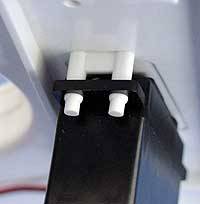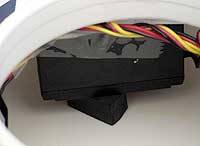Baby Black Blocks
(…say that 3 times fast!)
“Hmmm, those black rubber blocks must be some kind of packing material, I’ll just throw them away.” WRONG!
Servo Jacks
There are two baby black rubber blocks that perform a critical duty in your cockpit. They often are shaken loose from their assigned tasks during shipping – and they don’t give any clue what they are for. Please DO NOT throw them away!
These blocks complete one of the cleverest pieces of engineering in the RC Laser. They actually hold the two servos in place. Huh?
If you could see (and you can’t unless you take the deck plate off), there are four small posts molded into the underside of the deck plate at the location of each servo. They are sized to receive the four screw holes in each servo. The servos simply slip up on these four posts and are held firmly from twisting.
But the posts only hold the servos from moving in reaction to the load on the servo. They do not hold the servo up to the deck. And that is where the Baby Black Blocks come into play.
Secure in Place
I recommend you use a little rubber cement, or silicon, to keep these blocks securely in place. Simple wedge them under the servo, glue, and forget.
“But my blocks were just floating around in the cockpit and my servos were still in place.” Well, Yes and No. The reason your servos do not fall off their posts when the rubber blocks are removed is because they are actually hanging from their drive fittings above deck. The steering servo on the steering horn, and the sail servo on its drum.
As you can imagine, leaving the servos hanging on these fittings causes more friction, and allows the servo to sit slightly away from its deck port – which will allow water in. It also allows the servo to wallow a bit – and we don’t want our servos wallowing, do we?
So – check your Baby Black Blocks often to make sure they are firmly in place. And should you ever need to remove your servos, first undo the deck fitting, and then remove the block. The servo will slip down, and off, the ingenious mounting posts.
Now you know the rest of the story.
This article was written by Steve Lang of SailRC.com.


